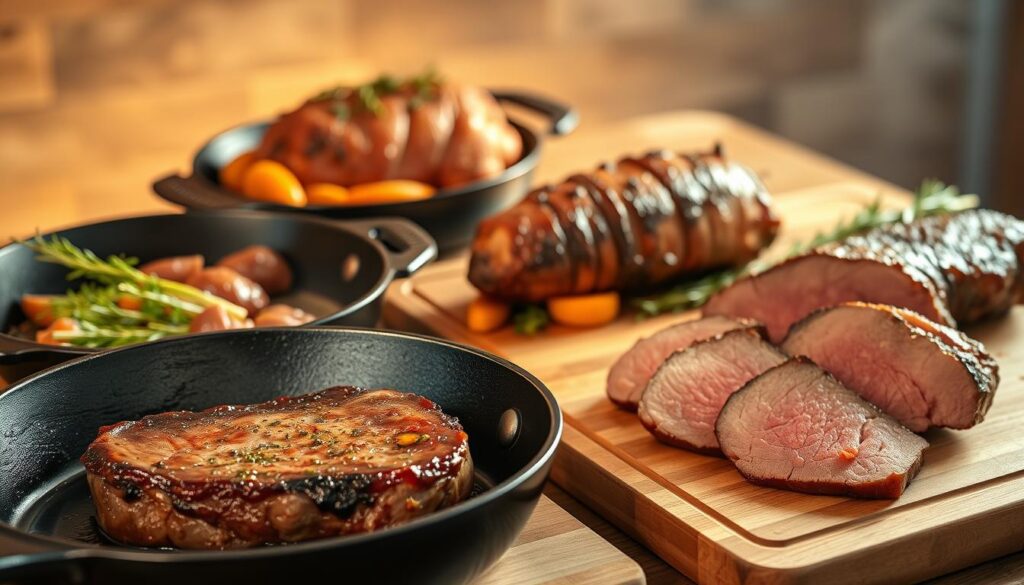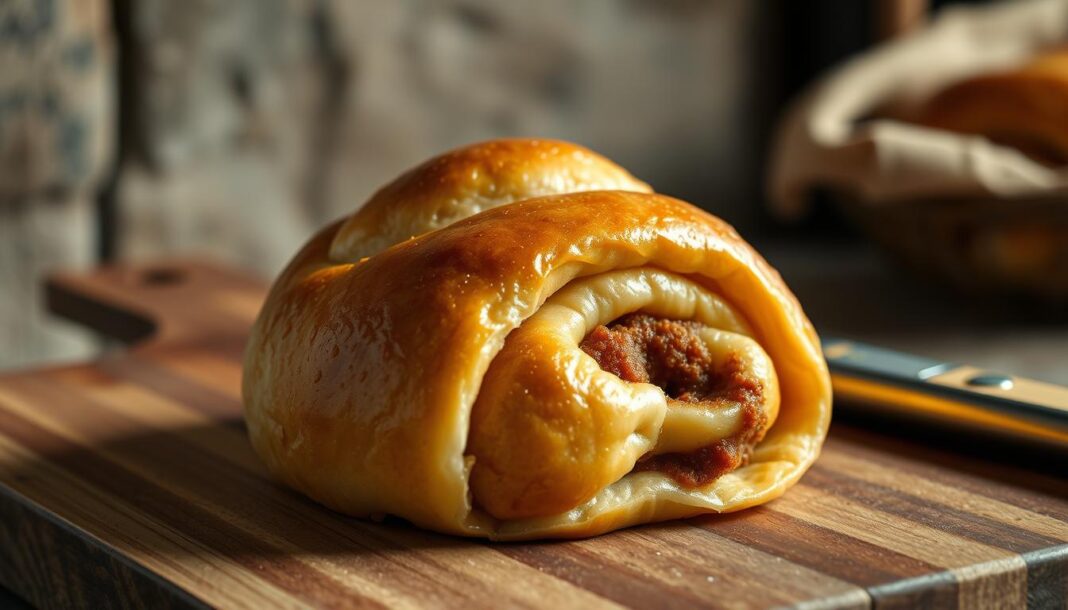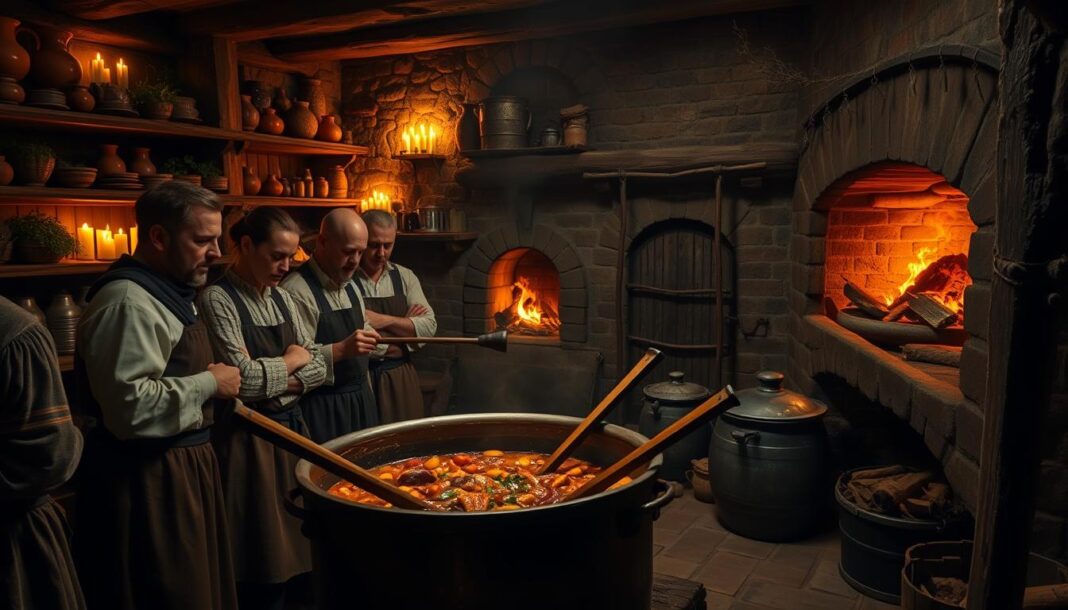Cooking venison in the oven can be a rewarding experience, yielding tender and flavorful results when done correctly. Venison, being a very lean meat, requires careful handling to avoid toughness—a common issue if it’s not cooked right.
The backstrap or deer loin is one of the most tender cuts of venison, and when cooked properly, it offers a deliciously lean alternative to traditional beef. At Historical Foods, we emphasize the importance of understanding the fundamentals of cooking wild game like venison.
Our comprehensive guide will walk you through the process, from preparation to serving, ensuring your venison dish is a success. We’ll also debunk common misconceptions about venison being tough or “gamey,” showing how proper cooking techniques can highlight its natural qualities.
Key Takeaways
- Venison is a lean meat that requires careful cooking to avoid toughness.
- Cooking venison in the oven yields tender and flavorful results.
- The backstrap or deer loin is one of the most tender cuts of venison.
- Proper cooking techniques can make venison a delicious alternative to beef.
- Understanding the fundamentals of cooking wild game is crucial for success.
Understanding Venison Basics
Venison, being a lean game meat, requires a deep understanding of its basics for optimal cooking. We need to consider its unique characteristics to bring out the best flavor and texture.
Different Cuts of Deer Meat
Deer meat, or venison, comes in various cuts, each with its own characteristics. The backstrap, running along the deer’s spine, is considered the premium cut due to its tenderness. Venison steaks from this cut are tender because the muscle has limited movement. In contrast, tenderloins are found under the spine and are smaller, cooking quickly and requiring careful attention.
| Cut | Description | Cooking Method |
|---|---|---|
| Backstrap | Tender cut along the spine | Quick cooking |
| Tenderloin | Smaller cuts under the spine | Careful quick cooking |
| Shoulder/Hindquarter | More muscular cuts | Slower cooking methods |
Why Venison Requires Special Cooking Techniques
Venison’s naturally lean composition means it has less fat compared to beef, necessitating modified cooking approaches to prevent dryness. The lack of marbling in deer meat affects how it conducts heat, cooking faster than fattier meats and requiring precise temperature control. For detailed guidance on cooking deer meat in the oven, you can refer to resources like Historical Foods.

Preparing Your Deer Meat for the Oven
Before you start cooking deer meat in the oven, it’s crucial to prepare it properly to achieve the best results. We will guide you through the essential steps to ensure your venison is cooked to perfection.
Thawing and Preparing the Meat
Proper thawing is essential for even cooking. We recommend thawing venison gradually in the refrigerator to maintain its texture and ensure food safety. Once thawed, pat the meat dry with paper towels to remove excess moisture, which helps achieve better browning and prevents steaming in the oven.
Seasoning Options for Venison
Venison’s lean profile makes it an excellent canvas for various seasonings. Simple combinations of salt, pepper, garlic, and herbs often yield the best results. For a basic seasoning, coat your meat with salt and black pepper. For added flavor, consider using other ingredients like paprika or thyme.
Optional Marinades for Enhanced Flavor
While marinades aren’t strictly necessary for quality cuts like backstrap, they can enhance flavor and tenderness, particularly for older animals or more muscular cuts. Acidic ingredients like vinegar or citrus juice help break down muscle fibers, while oil components retain moisture. A simple marinade can be made with Worcestershire sauce.
| Marinade Ingredients | Purpose | Example |
|---|---|---|
| Acidic ingredients (vinegar, citrus juice) | Break down muscle fibers | Worcestershire sauce |
| Oil components | Retain moisture | Olive oil |
| Herbs and spices | Add flavor | Thyme, garlic |
How to Cook Deer Meat in Oven: Step-by-Step Process
Mastering the art of cooking deer meat in the oven requires attention to detail and the right techniques. We will guide you through the process, ensuring that your venison turns out tender and flavorful every time.
Preheating and Temperature Settings
Preheating your oven to the proper temperature is crucial. For most venison cuts, preheating to 350-450°F is recommended. The exact temperature may vary depending on the cut and desired doneness.
Searing Techniques Before Oven Roasting
Searing venison before oven roasting creates a flavorful crust. Use a hot skillet, preferably cast-iron, to sear the meat for about 20 seconds on each side. This technique enhances the natural flavors and seals in juices.
Cooking Times for Different Cuts
Cooking times vary based on the cut and thickness. For example, backstrap cooked at 450°F typically takes 12-18 minutes. Always use a meat thermometer to ensure the correct internal temperature.
Using a Meat Thermometer for Perfect Results
A meat thermometer is essential for achieving perfect doneness. For medium-rare, aim for an internal temperature of 115-125°F. Remember, venison continues to cook slightly after being removed from the oven.
| Venison Cut | Cooking Temperature (°F) | Cooking Time (minutes) | Internal Temperature (°F) |
|---|---|---|---|
| Backstrap | 450 | 12-18 | 115-125 |
| Tenderloin | 425 | 10-15 | 115-125 |
| Roast | 325 | 20-25 | 130-135 |
Serving Your Perfectly Cooked Venison
With your venison cooked to perfection, it’s time to bring out the best in this lean meat. Let it rest for about 5 to 10 minutes before cutting into it, allowing the juices to redistribute and making for a more tender and flavorful experience.
Once rested, slice the venison against the grain to further enhance its tenderness. A pat of butter melting over the hot venison adds a richness that complements its lean nature.
Venison pairs beautifully with earthy flavors; consider serving it with roasted root vegetables or dark leafy greens. Unlike fattier beef, venison benefits from complementary sauces that add moisture and richness.
For a complete meal, balance the lean protein with starchy components like potatoes or wild rice. The versatility of venison means your perfectly cooked oven roast can be repurposed in various dishes if you have leftovers.


